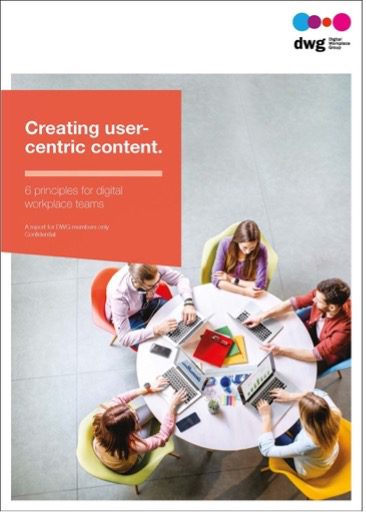Giving employees the best content for their needs: Six approaches to success

Well-managed intranets, at the core of any digital workplace, must satisfy the daily needs of employees by providing trustworthy, relevant and task-focused content in line with defined standards and controls. At the same time, they must align with broader organizational goals, relating to collaboration and remote working.
A strategic approach to the planning, implementation and monitoring of content and services is therefore required, supported by robust governance and a focus on employees and their experience as users, at every stage of development.
Core content needs to be relevant, current, engaging and designed around and for employees. This improves findability and drives successful outcomes for users; and yet, many organizations find content management and optimization practices challenging and therefore struggle to realize these outcomes.
Our latest DWG research report, Creating user-centric content: 6 principles for digital workplace teams, highlights how organizations can meet these challenges, based on good-practice criteria that DWG has identified through extensive evaluation and research of some of the world’s leading intranets and digital workplaces.
Apply tested user-centric content and design practices
The research provides an overview of key user-centric content and design practices – including how and when to use them, along with case studies where these are being used in practice.
Content on high-performing intranets tends to have a clearly identified need for the user. Services designed around users and their needs:
- are more likely to be used
- help more people to get the right outcome for them
- cost less to operate by reducing time and money spent on resolving problems.
It’s not all about the employee, the business has needs too!
This should apply to all content, but in reality there are always some areas that have a purely business purpose (something the organization needs to tell employees), or are ‘vanity publishing’, intended to raise awareness but with no real reason or call to action to attract a user.
To improve successful outcomes for employees, digital workplace or intranet teams should ensure that both content and new functionality meet their needs by employing both operational and strategic techniques.
Six practices provide a pathway to user-centric content
The report sets out six key practices for user-centred content, illustrated with case study examples. In addition, the DWG Institute, a safe space where organizations can collaborate, investigate and learn with a diverse range of workplace technology providers, enabled a further detailed case study through its partnership with Unily.
These practices are:
- Involving employees as users.
- Governing content with users in mind.
- Using personalization to target content.
- Using customization to help users surface content.
- Supporting users’ everyday information needs.
- Widening the scope of the intranet strategy.
Digital workplace governance provides a long-lasting foundation
Strong governance must underpin any content strategy. A content strategy analyses the problems content is designed to solve – and lays out how. It should document the audiences, the publishing model and the key user journeys that different areas are intended to deliver. In addition it should formalize content design practices, in particular for actionable content, such as searching for people or requesting leave.
At the high level, a content strategy can be listed as a set of components that organizations can use to support content across its full lifecycle: producing, publishing, appraising, archiving and deleting. The components that form the content strategy fall into two distinct groups:
- People components: define the team that owns, manages and shapes the content strategy so that continuous improvement can be achieved.
- Functional components: define the activities involved in managing the content effectively across the digital workplace.
Robust, well-planned governance and the practices outlined in this report will help create user-centric content which will be appreciated by employees, resulting in an improved return on investment for digital workplace managers, teams and budgets.
Download the free excerpt
Get access to the full report and 100+ other best practice digital workplace reports
DWG members have access to this full report, which delves into the six principles of how organizations can meet the challenges of providing high quality content in the digital workplace that it truly focused on the needs of users.
This report forms part of DWG’s best practice Research Library of 100+ reports covering key areas such as strategy and governance, personalization, user experience and change management for intranets and digital workplaces.
Browse our most recent reports and excerpts, and find out what’s coming up. Contact us to learn how to gain access to this library via DWG Membership.
Categorised in: → Internal communications, Content management
